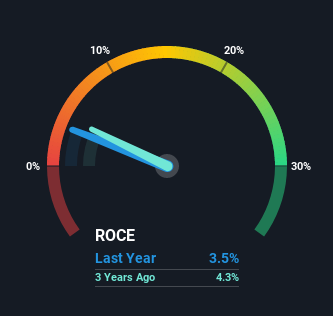
There are a few key trends to look for if we want to identify the next multi-bagger. Amongst other things, we'll want to see two things; firstly, a growing return on capital employed (ROCE) and secondly, an expansion in the company's amount of capital employed. If you see this, it typically means it's a company with a great business model and plenty of profitable reinvestment opportunities. However, after investigating Vikas Lifecare (NSE:VIKASLIFE), we don't think it's current trends fit the mold of a multi-bagger.
Return On Capital Employed (ROCE): What is it?
If you haven't worked with ROCE before, it measures the 'return' (pre-tax profit) a company generates from capital employed in its business. The formula for this calculation on Vikas Lifecare is:
Return on Capital Employed = Earnings Before Interest and Tax (EBIT) ÷ (Total Assets - Current Liabilities)
0.035 = ₹53m ÷ (₹2.0b - ₹501m) (Based on the trailing twelve months to September 2021).
Thus, Vikas Lifecare has an ROCE of 3.5%. In absolute terms, that's a low return and it also under-performs the Trade Distributors industry average of 9.0%.
See our latest analysis for Vikas Lifecare

Historical performance is a great place to start when researching a stock so above you can see the gauge for Vikas Lifecare's ROCE against it's prior returns. If you're interested in investigating Vikas Lifecare's past further, check out this free graph of past earnings, revenue and cash flow.
What The Trend Of ROCE Can Tell Us
There are better returns on capital out there than what we're seeing at Vikas Lifecare. The company has employed 200% more capital in the last five years, and the returns on that capital have remained stable at 3.5%. Given the company has increased the amount of capital employed, it appears the investments that have been made simply don't provide a high return on capital.
What We Can Learn From Vikas Lifecare's ROCE
In conclusion, Vikas Lifecare has been investing more capital into the business, but returns on that capital haven't increased. Since the stock has declined 44% over the last year, investors may not be too optimistic on this trend improving either. On the whole, we aren't too inspired by the underlying trends and we think there may be better chances of finding a multi-bagger elsewhere.
Vikas Lifecare does have some risks, we noticed 3 warning signs (and 1 which can't be ignored) we think you should know about.
For those who like to invest in solid companies, check out this free list of companies with solid balance sheets and high returns on equity.
New: Manage All Your Stock Portfolios in One Place
We've created the ultimate portfolio companion for stock investors, and it's free.
• Connect an unlimited number of Portfolios and see your total in one currency
• Be alerted to new Warning Signs or Risks via email or mobile
• Track the Fair Value of your stocks
Have feedback on this article? Concerned about the content? Get in touch with us directly. Alternatively, email editorial-team (at) simplywallst.com.
This article by Simply Wall St is general in nature. We provide commentary based on historical data and analyst forecasts only using an unbiased methodology and our articles are not intended to be financial advice. It does not constitute a recommendation to buy or sell any stock, and does not take account of your objectives, or your financial situation. We aim to bring you long-term focused analysis driven by fundamental data. Note that our analysis may not factor in the latest price-sensitive company announcements or qualitative material. Simply Wall St has no position in any stocks mentioned.
About NSEI:VIKASLIFE
Vikas Lifecare
Engages in the trading of polymers and chemicals, iron and steel, and plastic products in India, Mauritius, and Bangladesh.
Adequate balance sheet and slightly overvalued.
Market Insights
Community Narratives




